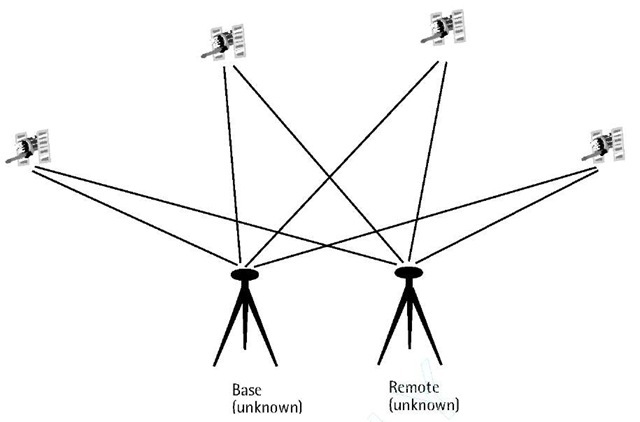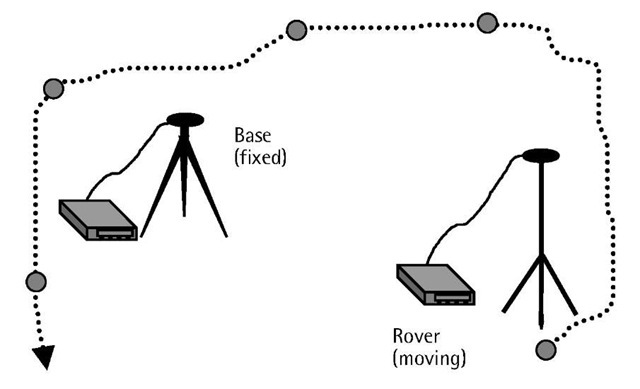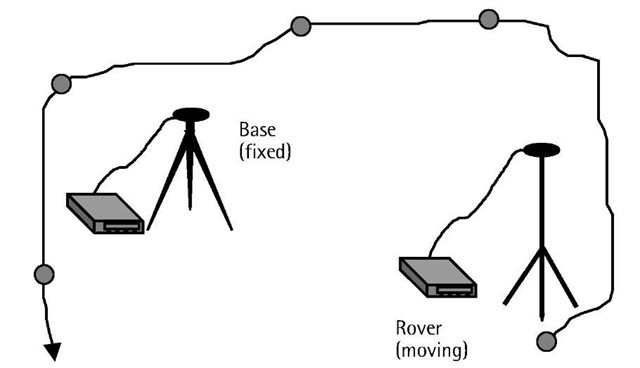Positioning with GPS can be performed by either of two ways: point positioning or relative positioning. GPS point positioning employs one GPS receiver that measures the code pseudoranges to determine the user’s position instantaneously, as long as four or more satellites are visible at the receiver. The expected horizontal positioning accuracy from the civilian C/A-code receivers has gone down from about 100m (2 drms) when selective availability was on, to about 22m (2 drms) in the absence of selective availability [1]. GPS point positioning is used mainly when a relatively low accuracy is required. This includes recreation applications and low-accuracy navigation.
GPS relative positioning, however, employs two GPS receivers simultaneously tracking the same satellites. If both receivers track at least four common satellites, a positioning accuracy level of the order of a subcenti-meter to a few meters can be obtained [2]. Carrier-phase or/and pseu-dorange measurements can be used in GPS relative positioning, depending on the accuracy requirements. The former provides the highest possible accuracy. GPS relative positioning can be made in either real-time or post-mission modes. GPS relative positioning is used for high-accuracy applications such as surveying and mapping, GIS, and precise navigation.
GPS point positioning
GPS point positioning, also known as standalone or autonomous positioning, involves only one GPS receiver. That is, one GPS receiver simultaneously tracks four or more GPS satellites to determine its own coordinates with respect to the center of the Earth (Figure 5.1). Almost all of the GPS receivers currently available on the market are capable of displaying their point-positioning coordinates.
To determine the receiver’s point position at any time, the satellite coordinates as well as a minimum of four ranges to four satellites are required [2]. The receiver gets the satellite coordinates through the navigation message, while the ranges are obtained from either the C/A-code or the P(Y)-code, depending on the receiver type (civilian or military). As mentioned before, the measured pseudoranges are contaminated by both the satellite and receiver clock synchronization errors. Correcting the satellite clock errors may be done by applying the satellite clock correction in the navigation message; the receiver clock error is treated as an additional unknown parameter in the estimation process [2]. This brings the total number of unknown parameters to four: three for the receiver coordinates and one for the receiver clock error. This is the reason why at least four satellites are needed. It should be pointed out that if more than four satellites are tracked, the so-called least-squares estimation or Kalman filtering technique is applied [2-4]. As the satellite coordinates are given in the WGS 84 system, the obtained receiver coordinates will be in the WGS 84 system as well.However, most GPS receivers provide the transformation parameters between WGS 84 and many local datums used around the world.
Figure 5.1 Principle of GPS point positioning.
GPS relative positioning
GPS relative positioning, also called differential positioning, employs two GPS receivers simultaneously tracking the same satellites to determine their relative coordinates (Figure 5.2). Of the two receivers, one is selected as a reference, or base, which remains stationary at a site with precisely known coordinates. The other receiver, known as the rover or remote receiver, has its coordinates unknown. The rover receiver may or may not be stationary, depending on the type of the GPS operation.
A minimum of four common satellites is required for relative positioning. However, tracking more than four common satellites simultaneously would improve the precision of the GPS position solution [2]. Carrier-phase and/or pseudorange measurements can be used in relative positioning. A variety of positioning techniques are used to provide a postprocessing (postmission) or real-time solution.
Figure 5.2 Principle of GPS relative positioning.
Details of the commonly used relative positioning techniques are given in Sections 5.3 to 5.7. GPS relative positioning provides a higher accuracy than that of autonomous positioning. Depending on whether the carrier-phase or the pseu-dorange measurements are used in relative positioning, an accuracy level of a subcentimeter to a few meters can be obtained. This is mainly because the measurements of two (or more) receivers simultaneously tracking a particular satellite contain more or less the same errors and biases [5]. The shorter the distance between the two receivers, the more similar the errors. Therefore, if we take the difference between the measurements of the two receivers (hence the name "differential positioning"), the similar errors will be removed or reduced.
Static GPS surveying
Static GPS surveying is a relative positioning technique that depends on the carrier-phase measurements [2]. It employs two (or more) stationary receivers simultaneously tracking the same satellites (see Figure 5.3). One receiver, the base receiver, is set up over a point with precisely known coordinates such as a survey monument (sometimes referred to as the known point). The other receiver, the remote receiver, is set up over a point whose coordinates are sought (sometimes referred to as the unknown point). The base receiver can support any number of remote receivers, as long as a minimum of four common satellites is visible at both the base and the remote sites.
In principle, this method is based on collecting simultaneous measurements at both the base and remote receivers for a certain period of time, which, after processing, yield the coordinates of the unknown point. The observation, or occupation, time varies from about 20 minutes to a few hours, depending on the distance between the base and the remote receivers (i.e., the baseline length), the number of visible satellites, and the satellite geometry. The measurements are usually taken at a recording interval of 15 or 20 seconds, or one sample measurement every 15 or 20 seconds.
After completing the field measurements, the collected data is downloaded from the receivers into the PC for processing. Different processing options may be selected depending on the user requirements, the baseline length, and other factors. For example, if the baseline is relatively short, say, 15 or 20 km, resolving the ambiguity parameters would be a key issue to ensure high-precision positioning.
Figure 5.3 Static GPS surveying.
As such, in this case the option of fixing the ambiguity parameters should be selected. In contrast, if the baseline is relatively long, a user may select the ionosphere-free linear combination option to remove the majority of the ionospheric error.This is because the ambiguity parameters may not be fixed reliably at the correct integer values. For very long baselines, for example, over 1,000 km, it is recommended that the user processes the data with one of the scientific software packages available, such as the BERENSE software developed by the University of Bern, rather than a commercial software package. The precise ephemeris should also be used in this case, as the effect of the orbital errors will be considerably different at the two ends of the baseline.
Static GPS surveying with the carrier-phase measurements is the most accurate positioning technique. This is mainly due to the significant change in satellite geometry over the long observation time span. Although both the single- and dual-frequency receivers can be used for static positioning, the latter is often used, especially for baselines exceeding 20 km.
The expected accuracy from a geodetic quality receiver is typically 5 mm + 1 ppm (rms), ppm for parts per million and rms for root-mean-square. That is, for a 10-km baseline, for example, the expected accuracy of the static GPS surveying is 1.5 cm (rms). Higher accuracy may be obtained by, for example, applying the precise ephemeris.
Fast (rapid) static
Fast, or rapid, static surveying is a carrier-phase-based relative positioning technique similar to static GPS surveying. That is, it employs two or more receivers simultaneously tracking the same satellites. However, with rapid static surveying, only the base receiver remains stationary over the known point during the entire observation session (see Figure 5.4). The rover receiver remains stationary over the unknown point for a short period of time only, and then moves to another point whose coordinates are sought [2]. Similar to the static GPS surveying, the base receiver can support any number of rovers.
This method is suitable when the survey involves a number of unknown points located in the vicinity (i.e., within up to about 15 km) of a known point. The survey starts by setting up the base receiver over the known point, while setting up the rover receiver over the first unknown point (Figure 5.4).
Figure 5.4 Fast (rapid) static GPS surveying.
The base receiver remains stationary and collects data continuously. The rover receiver collects data for a period of about 2 to 10 minutes, depending on the distance to the base as well as the satellite geometry [2]. Once the rover receiver has collected the data, the user moves to the following point with unknown coordinates and repeats the procedures. It should be pointed out that, while moving, the rover receiver may be turned off. Due to the relatively short occupation time for the rover receiver, the recording interval is reduced to 5 seconds.
After collecting and downloading the field data from both receivers, the PC software is used for data processing. Depending on whether enough common data was collected, the software may output a fixed solution, which indicates that the ambiguity parameters were fixed at integer values.Otherwise, a float solution is obtained, which means that the software was unable to fix ambiguity parameters at integer values (i.e., only real-valued ambiguity parameters were obtained). This problem occurs mainly when the collected GPS data is insufficient. A fixed solution means that the positioning accuracy is at the centimeter level, while the float solution means that the positioning accuracy is at the decimeter or submeter level. Although both the single- and dual-frequency receivers can be used for fast static surveying, the probability of getting a fixed solution is higher with the latter.
Stop-and-go GPS surveying
Stop-and-go surveying is another carrier-phase-based relative positioning technique. It also employs two or more GPS receivers simultaneously tracking the same satellites (Figure 5.5): a base receiver that remains stationary over the known point and one or more rover receivers [2]. The rover receiver travels between the unknown points, and makes a brief stop at each point to collect the GPS data. The data is usually collected at a 1- to 2-second recording rate for a period of about 30 seconds per each stop. Similar to the previous methods, the base receiver can support any number of rovers. This method is suitable when the survey involves a large number of unknown points located in the vicinity (i.e., within up to 10-15 km) of a known point.
Figure 5.5 Stop-and-go GPS surveying.
The survey starts by first determining the initial integer ambiguity parameters, a process known as receiver initialization. This could be done by various methods, discussed in the next topic. Once the initialization is performed successfully, centimeter-level positioning accuracy can be obtained instantaneously. This is true as long as there is a minimum offour common satellites simultaneously tracked by both the base and the rover receivers at all times. If this condition is not fulfilled at any moment during the survey, the initialization process must be repeated to ensure centimeter-level accuracy.
Following the initialization, the rover moves to the first unknown point. After collecting about 30 seconds of data, the rover moves, without being switched off, to the second point and the procedures are repeated. It is of utmost importance that at least four satellites are tracked, even during the move; otherwise the initialization process must be repeated again by, for example, reoccupying the previous point. Some manufacturers, for example, Ashtech Inc., recommend the reoccupation of the first point at the end of the survey. This turned out to be very useful in obtaining a fixed solution provided that the processing software has the forward and backward processing functions. Once the data is collected and downloaded, PC software is used to process it. Some software packages have the forward and backward processing functions, which help in obtaining a fixed solution, or centimeter-level accuracy. Both single- and dual-frequency receivers may use the stop-and-go surveying method.
A special case of stop-and-go surveying is known as kinematic GPS surveying. Both methods are the same in principle; however, the latter requires no stops at the unknown points. The positional accuracy is expected to be higher with the stop-and-go surveying, as the errors are averaged out when the receiver stops at the unknown points.





